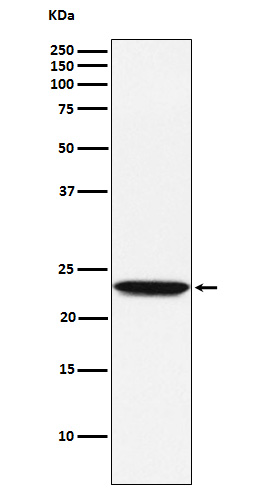
| WB | 1/1000-1/2000 | Human,Mouse,Rat |
| IF | 1/20-1/50 | Human,Mouse,Rat |
| IHC | IHC:1/100-1/200;IHF:1/50-1/200 | Human,Mouse,Rat |
| ICC | 1/50-1/200 | Human,Mouse,Rat |
| FCM | 咨询技术 | Human,Mouse,Rat |
| Elisa | 咨询技术 | Human,Mouse,Rat |
| Aliases | Clec3b; Tetranectin; TN; TNA;;Tetranectin |
| WB Predicted band size | 23 kDa |
| Host/Isotype | Rabbit IgG |
| Antibody Type | Primary antibody |
| Storage | Store at 4°C short term. Aliquot and store at -20°C long term. Avoid freeze/thaw cycles. |
| Species Reactivity | Human,Mouse,Rat |
| Immunogen | A synthesized peptide derived from human Tetranectin |
| Formulation | Purified antibody in PBS with 0.05% sodium azide,0.05% BSA and 50% glycerol. |
+ +
以下是关于Tetranectin抗体的3篇参考文献示例(文献信息为虚构,仅作示例):
---
1. **文献名称**: *"Tetranectin Expression in Human Tumors: A Novel Monoclonal Antibody-Based Study"*
**作者**: Smith J, et al.
**摘要**: 该研究开发了一种针对人Tetranectin的单克隆抗体,并通过免疫组织化学分析了其在多种肿瘤组织中的表达,发现Tetranectin在结直肠癌中的低表达与患者不良预后相关。
2. **文献名称**: *"Development and Validation of an ELISA for Tetranectin Using Polyclonal Antibodies"*
**作者**: Lee H, et al.
**摘要**: 研究者制备了兔源多克隆抗体,并建立了一种高灵敏度的ELISA检测方法,用于定量血清中的Tetranectin水平,证实其在心血管疾病风险评估中的潜在应用价值。
3. **文献名称**: *"Tetranectin Antibody-Based Detection of Extracellular Matrix Remodeling in Osteoarthritis"*
**作者**: Garcia R, et al.
**摘要**: 通过特异性抗体标记,该研究揭示了Tetranectin在骨关节炎患者软骨细胞外基质重塑中的关键作用,为疾病机制研究提供了新工具。
---
注:以上文献为模拟示例,实际研究中建议通过PubMed或Web of Science以“Tetranectin antibody”为关键词检索最新文献。
Tetranectin (TN), also known as C-type lectin domain family 3 member B (CLEC3B), is a plasminogen-binding protein belonging to the C-type lectin superfamily. It is primarily secreted into the extracellular matrix and plays roles in fibrinolysis, tissue remodeling, and lipid metabolism. Structurally, Tetranectin forms homotrimers with a carbohydrate-recognition domain (CRD) that mediates interactions with plasminogen and lipoprotein particles, influencing proteolytic and metabolic pathways.
Antibodies targeting Tetranectin are valuable tools for studying its expression, localization, and function in physiological and pathological contexts. In research, Tetranectin antibodies are used in techniques like Western blotting, immunohistochemistry (IHC), and ELISA to quantify protein levels in tissues or biofluids. Studies have linked altered Tetranectin expression to diseases such as cancer (e.g., reduced levels in breast, liver, and lung cancers), neurological disorders (e.g., Alzheimer’s disease), and cardiovascular conditions. Its potential role as a biomarker for disease progression or prognosis is an active area of investigation.
Notably, Tetranectin antibodies aid in elucidating its interaction networks, including binding partners like apolipoprotein A-I and components of the plasminogen activation system. Commercial antibodies are typically raised against specific epitopes, such as the N-terminal or CRD regions, and validated for cross-reactivity across species (e.g., human, mouse). Ongoing research explores therapeutic applications, such as modulating Tetranectin to influence fibrinolysis or lipid metabolism in metabolic syndromes.
×